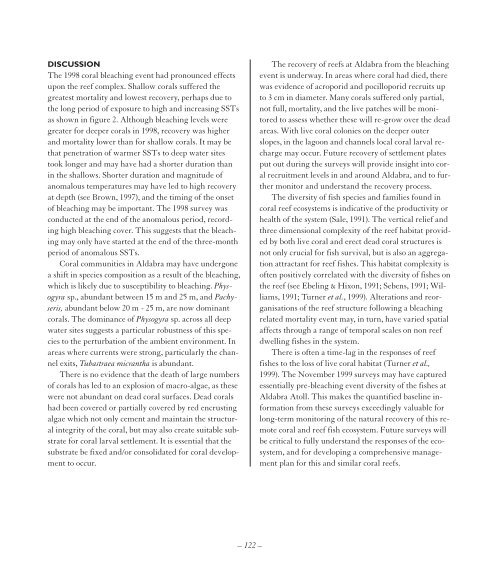Create successful ePaper yourself
Turn your PDF publications into a flip-book with our unique Google optimized e-Paper software.
DISCUSSION<br />
The 1998 coral bleaching event had pronounced effects<br />
upon the reef complex. Shallow corals suffered the<br />
greatest mortality and lowest recovery, perhaps due to<br />
the long period of exposure to high and increasing SSTs<br />
as shown in figure 2. Although bleaching levels were<br />
greater for deeper corals in 1998, recovery was higher<br />
and mortality lower than for shallow corals. It may be<br />
that penetration of warmer SSTs to deep water sites<br />
took longer and may have had a shorter duration than<br />
in the shallows. Shorter duration and magnitude of<br />
anomalous temperatures may have led to high recovery<br />
at depth (see Brown, 1997), and the timing of the onset<br />
of bleaching may be important. The 1998 survey was<br />
conducted at the end of the anomalous period, recording<br />
high bleaching cover. This suggests that the bleaching<br />
may only have started at the end of the three-month<br />
period of anomalous SSTs.<br />
Coral communities in Aldabra may have undergone<br />
a shift in species composition as a result of the bleaching,<br />
which is likely due to susceptibility to bleaching. Physogyra<br />
sp., abundant between 15 m and 25 m, and Pachyseris,<br />
abundant below 20 m - 25 m, are now dominant<br />
corals. The dominance of Physogyra sp. across all deep<br />
water sites suggests a particular robustness of this species<br />
to the perturbation of the ambient environment. In<br />
areas where currents were strong, particularly the channel<br />
exits, Tubastraea micrantha is abundant.<br />
There is no evidence that the death of large numbers<br />
of corals has led to an explosion of macro-algae, as these<br />
were not abundant on dead coral surfaces. Dead corals<br />
had been covered or partially covered by red encrusting<br />
algae which not only cement and maintain the structural<br />
integrity of the coral, but may also create suitable substrate<br />
for coral larval settlement. It is essential that the<br />
substrate be fixed and/or consolidated for coral development<br />
to occur.<br />
The recovery of reefs at Aldabra from the bleaching<br />
event is underway. In areas where coral had died, there<br />
was evidence of acroporid and pocilloporid recruits up<br />
to 3 cm in diameter. Many corals suffered only partial,<br />
not full, mortality, and the live patches will be monitored<br />
to assess whether these will re-grow over the dead<br />
areas. With live coral colonies on the deeper outer<br />
slopes, in the lagoon and channels local coral larval recharge<br />
may occur. Future recovery of settlement plates<br />
put out during the surveys will provide insight into coral<br />
recruitment levels in and around Aldabra, and to further<br />
monitor and understand the recovery process.<br />
The diversity of fish species and families found in<br />
coral reef ecosystems is indicative of the productivity or<br />
health of the system (Sale, 1991). The vertical relief and<br />
three dimensional complexity of the reef habitat provided<br />
by both live coral and erect dead coral structures is<br />
not only crucial for fish survival, but is also an aggregation<br />
attractant for reef fishes. This habitat complexity is<br />
often positively correlated with the diversity of fishes on<br />
the reef (see Ebeling & Hixon, 1991; Sebens, 1991; Williams,<br />
1991; Turner et al., 1999). Alterations and reorganisations<br />
of the reef structure following a bleaching<br />
related mortality event may, in turn, have varied spatial<br />
affects through a range of temporal scales on non reef<br />
dwelling fishes in the system.<br />
There is often a time-lag in the responses of reef<br />
fishes to the loss of live coral habitat (Turner et al.,<br />
1999). The November 1999 surveys may have captured<br />
essentially pre-bleaching event diversity of the fishes at<br />
Aldabra Atoll. This makes the quantified baseline information<br />
from these surveys exceedingly valuable for<br />
long-term monitoring of the natural recovery of this remote<br />
coral and reef fish ecosystem. Future surveys will<br />
be critical to fully understand the responses of the ecosystem,<br />
and for developing a comprehensive management<br />
plan for this and similar coral reefs.<br />
– 122 –


















